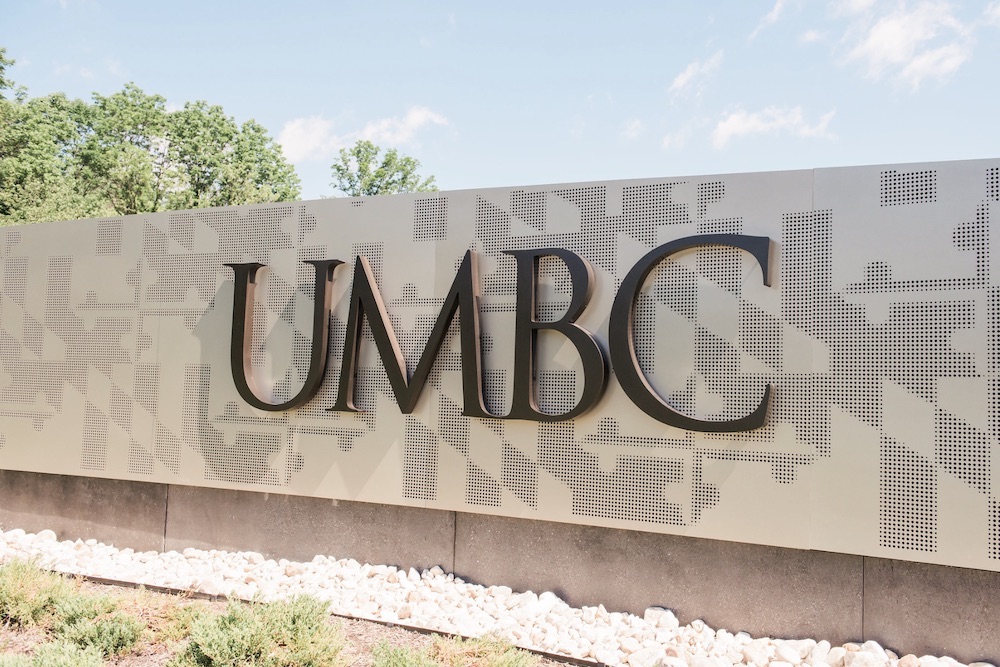In keeping with one of its core values — the execution of “public research for public good” — the University of Maryland, Baltimore County (UMBC) recently published a report cataloging the widespread innovative work of the various research departments, scholars and centers housed at its Hilltop Circle campus in Catonsville, Maryland. These research efforts extend through the limbs of the institution’s alumni and beyond, from flexible antiviral compounds to small teams of physicists uncovering the latest behaviors of black holes.
The report, “Inquiring Minds,” showcases the institution’s research and creative achievement initiatives. Spearheaded by the Office of Research and Creative Achievement (ORCA), it aims to highlight UMBC’s vibrant culture of collaboration across different fields, as well as its unique approach to engaging students in mentored research.
UMBC’s recent classification as an R1 university by the Carnegie Classification of Institutions of Higher Education places the university among the top 146 research (and only R1) universities in the country. This designation, which opens research universities to more federal and state funds, was one of the driving forces behind the report’s release.
UMBC’s Assistant Director of Research and Creative Achievement Communications Adriana Fraser, one of the editors behind “Inquiring Minds,” described the report as a major benchmark and accomplishment for the university.
“Our researchers across the academic departments and various research centers and institutes are working in support of UMBC’s mission to contribute to the economic development of the state and the region through entrepreneurial initiatives, workforce training, K-16 partnerships and technology commercialization in collaboration with public agencies and the corporate community,” said Fraser, a prior Technical.ly contributor, in an email to Technical.ly.
The report specifically illuminates work in such fields as climate and environmental sciences, data science, AI, cybersecurity, equity, social justice, health and life sciences. Here are some highlights from each section:
Climate and environmental sciences
- Land-based aquaculture, which is less susceptible to disease and results in fresher fish, is gaining popularity in the US. Yonathan Zohar, a professor of marine biotechnology, has played a significant role in the paradigm shift toward land-based aquaculture.
- The Interdisciplinary Consortium for Applied Research in the Environment (ICARE) master’s program focuses on community-engaged research using bat guano to detect heavy metals. The program engages South Baltimore residents in the zero-waste movement, as well as studying a new method of oyster aquaculture.
- Assistant professor Deepa Madan received a phase 1 MII award to develop zinc-chitosan gel-based batteries that are enclosed in flexible plastic and could revolutionize how everyday electronics are powered. Madan also earned a prestigious National Science Foundation (NSF) CAREER award for researching materials that could improve wearable medical devices.
Data science, AI and cybersecurity
- Within the Institute for Harnessing Data and Model Revolution in the Polar Regions (iHARP), a team of researchers led by Vandana Janeja uses data science, machine learning, AI and polar science to analyze enormous volumes of climate and help populations prepare for possible climate change-fueled flooding.
- “The research we are doing in iHARP will help us understand global drivers of sea level rise and its impacts,” Janeja said in the report.
- UMBC is a founding member of the International Cybersecurity Center of Excellence (INCS-CoE). a global university network dedicated to securing critical systems against cyber threats.
- The US military invests heavily in AI technology to strengthen its national defense infrastructure. A UMBC team thus partnered with the University of Maryland, College Park (UMD) and the DEVCOM Army Research Lab on the AI and Autonomy for Multi-Agent Systems (ArtIAMAS) project. ArtIAMAS aims to advance science and technology in the areas of collaborative autonomy, harnessing the data revolution and human-machine teaming for military functions.
- “To make a big impact in the research space, you need long-term, multiinstitutional partnerships and collaborations,” said UMBC information systems professor and ArtIAMAS’ principal investigator Aryya Gangopadhyay.
- James Foulds, an assistant professor of information systems, focuses his lab’s work on developing human-centered approaches to improve the fairness and robustness of AI algorithms, and he recently received a National Science Foundation CAREER Award of almost $550,000 over five years to support his research.
- The Maryland Institute for Innovative Computing (MIIC) continues to grow the pipeline of tech talent ready to support state agencies.
Community, equity and social justice
- Since the start of the COVID-19 pandemic, Charissa Cheah, professor of psychology, focused her research on using antiracist frameworks to address the recent increase in anti-Asian violence and discrimination. Cheah, along with other UMBC faculty, students, and researchers from UMCP received a Rapid Response Research grant from the National Science Foundation to support this work.
- Nkiru Nnawulezi and Liz Odongo co-founded the Domestic Violence Action Research Collective with funding from the Center for Victim Research.
- “I believe that it’s possible for us to have a city where survivors [of domestic violence] are treated justly and fairly.” —Nkiru Nnawulezi
Health and life sciences
- Chemistry professor Katherine Seley-Radtke contributed her innovative work on more flexible antiviral compounds to the National Institute of Allergy and Infectious Diseases’ Antiviral Drug Discovery Centers for Pathogens of Pandemic Concern. As a member of the University of North Carolina at Chapel Hill-led consortium, UMBC is guaranteed $2.2 million for the first three years and another $1.3 million for the final two years if the projects make satisfactory progress.
- A team including professors Erin Lavik and Chuck Bieberich developed a unique way of modifying the surfaces of nanoparticles within lifesaving medications to provide infusions that can be delivered more quickly while reducing the risk of negative reactions.
- The College of Natural and Mathematical Sciences received $5.6 million from the National Institutes of Health in 2022 to fund the Graduate Research Training Initiative for Student Enhancement (G-RISE) led by Rachel Brewster. The program aims to support graduate students from underrepresented groups in STEM with funding for up to three years and training opportunities. The initiative will be supported for five years.
Creative engagement
- UMBC’s Fellows for Faculty Diversity program attracts diverse scholars and prepares them for possible tenure-track appointments. Creative technologist and multimedia artist Tahir Hemphill was among the nearly two dozen scholars who joined UMBC through the program. Hemphill was the university’s inaugural Fellow for Faculty Diversity in the Visual Arts, which is specifically designed to support creative and artistic practitioners.
- Daniel Pesca, assistant professor of music, developed initiatives to advance diversity, equity, and inclusion in classical music, which includes the Hrabowski Innovation Fund Award for Keys to Inclusion, a multi-year initiative to imagine a more inclusive piano canon.
- Technical director Mark Jarzynski and associate professor Marc Olano, who both work with the Imaging Research Center (IRC), collaborated to evaluate methods of generating “random” visualizations to achieve the appearance of realism using computer-generated graphic imagery.
- Visual arts professor Lynn Cazabon approached the IRC with a project to help address climate change by capturing and sharing people’s personal experiences of winter and the emotional impact of global warming.
- George Derek Musgrove, associate professor of history, worked with the IRC in 2019 to further develop a storytelling website sharing his research on the history of Black Power activism in DC since the early 1960s.
Earth and space sciences
- NASA awarded a $72 million grant over three years for the new Goddard Earth Sciences Technology and Research (GESTAR) II Center, with UMBC leading a national consortium and receiving over $38 million.
- Physics professor Vanderlei Martins and Earth and Space Institute colleagues developed a mini-satellite, the Hyper-Angular Rainbow Polarimeter, which was launched to the International Space Station in November 2019 and released into orbit in February 2020.
- Associate professor of physics Eileen Meyer and her team are uncovering new information about black holes and how they behave.
History, identity and society
- The aforementioned Musgrove was selected as a 2022 Andrew Carnegie Fellow. This prestigious fellowship, which provides $200,000 to its recipients, will support Musgrove’s research in the humanities and social sciences. In 2021, Musgrove created an interactive website called Black Power in Washington, D.C., 1961-1998, which maps the major events and organizations of the Black Power movement in the city.
- Elizabeth Patton, associate professor of media and communication studies, authored a book called “Easy Living: The Rise of the Home Office” that examines how public figures, tech companies, real estate firms and visual media have all shaped the idea of working from home.
- Nicole King, a professor of American studies and the director of the Orser Center for the Study of Place, Community and Culture, spent the past decade working with colleagues to develop public humanities research methods that address disparities, misrepresentations, and inequalities in Baltimore City and the classroom.
Before you go...
Please consider supporting Technical.ly to keep our independent journalism strong. Unlike most business-focused media outlets, we don’t have a paywall. Instead, we count on your personal and organizational support.
Join our growing Slack community
Join 5,000 tech professionals and entrepreneurs in our community Slack today!

Entrepreneurship is changing, and so is the economic development behind it

What a $10M Department of Energy award means for Baltimore’s hydrogen future

10 tech and startup events to jump start your 2025


